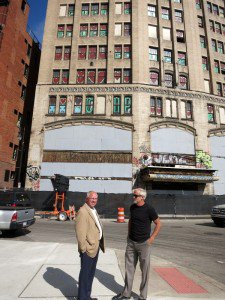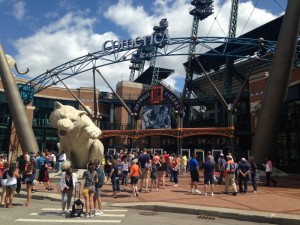Share This
Related Posts
Tags
Commercial Comeback
By Leah Etling on Dec 17, 2014 in News
Ed. note: The third in a three-part series, our final article on the real estate realities for Detroit, Michigan, as the city emerges from a long period of decline. Read the first installments here (Part 1) and here (Part 2).
Walking around downtown Detroit, at many times of day, feels like one has wandered onto a deserted movie set. Historic skyscrapers loom overhead. There are hints of change and progress: work on a new rail line, construction fences around old buildings, for rent signs in windows. What you don’t see, that feels strangest of all, are very many people.
At 8 a.m. and 5 p.m., there is foot traffic as employees walk to or from their jobs. A great many of them are wearing Quicken Loan employee ID badges, identifying them as part of Dan Gilbert’s empire. Gilbert’s investment in the city, from real estate purchases – more than 50 buildings to date – in addition to centering Quicken’s headquarters downtown and funding a large portion of the M:1 RAIL line, is ubiquitous.
“Dan Gilbert obviously is leading the charge in downtown real estate reinvestment. He’s acquired 52 properties in the last couple of years, for Quicken and various subsidiary companies of his own,” said John Latessa, Senior Managing Director of CBRE’s Michigan operations. The other major property accumulator, the Caesars Pizza-founding, sports team-owning Ilitch family, has been buying up lots and decaying buildings for a new hockey stadium for years.
“(Gilbert and the Ilitches) are generating the interest that didn’t exist before. If they weren’t doing this stuff and couldn’t do it on their own, a lot of these other projects wouldn’t be possible,” said Scott Allen, president of Fourmidable, a Detroit-based multifamily property management firm.
Rising rents for multifamily
Detroit’s real estate recovery, experts say, is a medley of hits and misses. You can still buy a livable house for less than $20,000 in the suburbs. Or you can pay more than $200,000 – and should expect to, as inventory is limited – for a new condo or loft in the coveted Midtown area.
“You can’t understand Detroit real estate because it doesn’t make any sense,” says Adam Hollier, former liaison to the Detroit City Council under Mayor Dave Bing. Comparing the market to other major U.S. urban centers is not possible – Detroit has too many unique problems, and in some cases, surprising opportunities.
For apartment renters, rents in the Downtown/Midtown area have come up more than 50 percent over the last few years – they currently average between $1.50 to $1.90/square foot. Though there’s estimated to be forthcoming demand for about 5,000 to 7,000 apartment units in the area, just 2,000 are under construction, hence the rise in rents.
“The renters are people coming to work for Compuware and Quicken Loans, largely. Detroit Edison and Blue Cross Blue Shield have moved employees into the area as well,” said Allen.
A locally based third-party fee manager, Fourmidable handles market rate apartments, senior properties, and affordable housing. They’ve picked up a variety of new inventory as a result of the regional growth in multi-family and now handle 6,500 units.
At Lafayette Towers, a 600-unit community Fourmidable manages that’s walkable to downtown and the Riverfront, Section 8 residents have moved out and market-rate tenants are moving in. A 21st floor, 1400 sf one-bedroom with new carpet and a view of the downtown skyline goes for around $1,000/month, an unheard of price for the property not too long ago.
“We were full, so I said: ‘Let’s push rents and see what happens,’” said Allen. The only vacant units in the Towers are those that have just undergone renovation. Another Fourmidable-managed property in the heart of downtown, the Fort Shelby Tower Apartments, was originally intended as condos, but is now at full occupancy for $1.90/sf.
With the expansion of corporate footprints in the downtown core, employment generates demand. Market rate housing subsidies are offered to workers from Blue Cross Blue Shield of Michigan, Compuware, DTE Energy, Marketing Associates, Quicken Loans or Strategic Staffing Solutions. They can qualify for a forgivable home loan of $20,000 of a $2,500 rental credit for an apartment, followed by a $1,000 credit for the second lease year. The program seems to be working – more people are moving into downtown units, and vacancy rates are around 2 percent.
Differentiating the commercial core
Turn toward the commercial sector, and things are moving at a more tempered pace.
“Mixed-use presents a higher degree of difficulty (for financing),” says David Wilkins, Vice President of Pillar Finance, an affiliate of Guggenheim Partners. “The retail hasn’t caught up with the residential yet.”
Indeed, one of the noticeable themes in the downtown core is empty storefronts, the vast majority of them controlled by Bedrock, Gilbert’s real estate holding firm. Along Woodward Avenue, where the M:1 line is being constructed, there are very few shops for pedestrians to patronize. Late this summer, Woodward was closed for the rail project construction, resulting in even lower pedestrian traffic than normal.
Moosejaw, a regional outdoors company, has a small shop along Woodward Avenue. So does The Detroit Shoppe, which sells vintage-style Detroit tees, beer glasses and other souvenirs. In the same block is D:Hive, which gives tours to corporate recruits who may find themselves calling Detroit home. Other than a CVS and a Buffalo Wild Wings, there is no sign of any national retail chains in the downtown core.
“Downtown needs to differentiate itself from suburban metro Detroit. The way it does that is through the art institute, the universities, the medical center and sporting opportunities,” said Latessa of CBRE. For the first time in many years, his office is fielding inquiries from suburban business clients about commercial space south of Midtown, a major change.
“That alone is a blue sky moment. You’re starting to see people genuinely consider downtown, where that was not part of the thought process before,” he said.
Whole Foods made a huge splash when it opened in Midtown in summer 2013, to the delight of shoppers, who have packed the parking lot and store aisles ever since. Midtown is Detroit’s most walkable neighborhood, hence its popularity with loft and condo buyers. There are restaurants, shops, coffeehouses, bars, yoga studios, a historic bowling alley, and many more amenities.
“The silver lining to investors ignoring us for so long was that we didn’t get overrun with chain restaurants and big box stores,” says Jeanette Pierce, a longtime downtown resident who started tours around the commercial center so that locals could get to better know their own city. “Now that as a country we’re waking up and realizing we don’t even like that stuff, Detroit is automatically king. All we have is local.”

Game day at Comerica Park, home to the Detroit Tigers.
With stadiums for the Detroit Tigers, Lions and Red Wings all located in the downtown area, easy access to sports is a big part of both local pride and another incentive to live downtown. For home games, several acres of open-air parking lots near Comerica Park (Tigers), or Ford Field (Lions), fill with cars of fans. Some locals gripe that while there are certainly economic boosts from the stadiums, they leave the area desolate of consumers and foot traffic when it isn’t game day.
Relocation of the Red Wings to a new stadium between Downtown and Midtown is expected to bring enhanced investment and interest to the rundown area between the two neighborhoods. Announced this summer by team owners Mike and Marian Ilitch, the development will recreate more than 10 square city blocks with mixed-use housing, retail, restaurants and other development around the stadium footprint. A $1.8 billion economic impact and more than 8,000 construction jobs are forecast.
“It will bridge desolation between here and the central business district, and I think the effect will be contagious,” said Dan Monahan, a local contractor whose family business has worked on numerous historic residential and commercial rehab projects.
CBRE’s Latessa agrees. “You’re seeing already people start to look at where the footprint of that arena is going to be, and eyeballing surrounding properties for repurposing as multifamily.” Residual commercial opportunities – both for sports fans, workers and multifamily residents – can’t be far behind.
